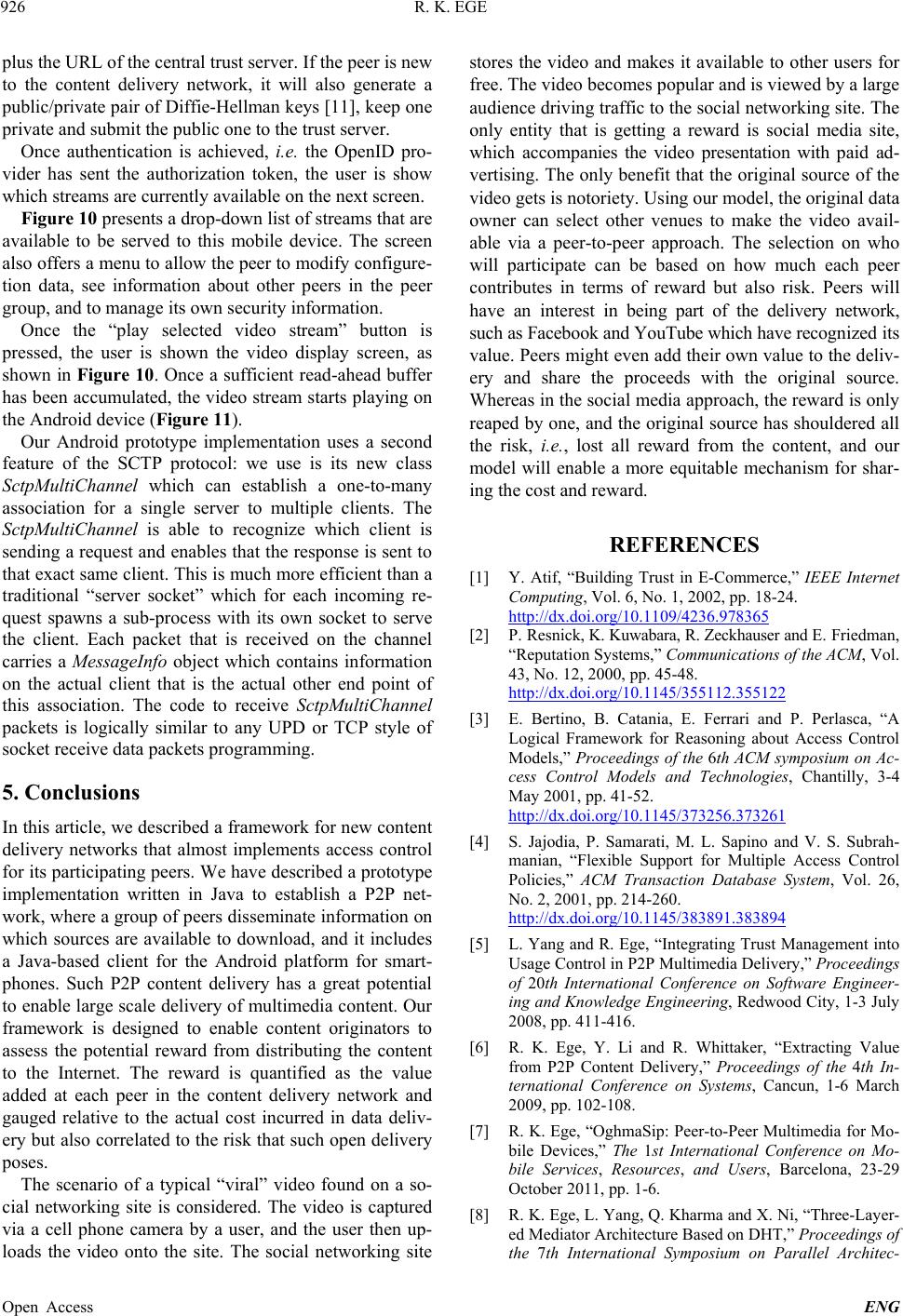
R. K. EGE
926
plus the URL of the central trust server. If the peer is new
to the content delivery network, it will also generate a
public/private pair of Diffie-Hellman keys [11], keep one
private and submit the pub lic one to the trust server.
Once authentication is achieved, i.e. the OpenID pro-
vider has sent the authorization token, the user is show
which streams are currently available on the next screen.
Figure 10 presents a drop-down list of streams that are
available to be served to this mobile device. The screen
also offers a menu to allow the peer to modify configure-
tion data, see information about other peers in the peer
group, and to manage its own security information.
Once the “play selected video stream” button is
pressed, the user is shown the video display screen, as
shown in Figure 10. Once a sufficient read-ahead buffer
has been accumulated, the video stream starts playing on
the Android device (Figure 11).
Our Android prototype implementation uses a second
feature of the SCTP protocol: we use is its new class
SctpMultiChannel which can establish a one-to-many
association for a single server to multiple clients. The
SctpMultiChannel is able to recognize which client is
sending a request and en ables that the response is sent to
that exact same client. This is much more efficient than a
traditional “server socket” which for each incoming re-
quest spawns a sub-process with its own socket to serve
the client. Each packet that is received on the channel
carries a MessageInfo object which contains information
on the actual client that is the actual other end point of
this association. The code to receive SctpMultiChannel
packets is logically similar to any UPD or TCP style of
socket receive data packets programming.
5. Conclusions
In this article, we described a framework for new content
delivery networks that almost implements access control
for its participating peers. We have described a prototype
implementation written in Java to establish a P2P net-
work, where a group of peers disseminate information on
which sources are available to download, and it includes
a Java-based client for the Android platform for smart-
phones. Such P2P content delivery has a great potential
to enable large scale d elivery of multimedia content. Our
framework is designed to enable content originators to
assess the potential reward from distributing the content
to the Internet. The reward is quantified as the value
added at each peer in the content delivery network and
gauged relative to the actual cost incurred in data deliv-
ery but also correlated to the risk that su ch open delivery
poses.
The scenario of a typical “viral” video found on a so-
cial networking site is considered. The video is captured
via a cell phone camera by a user, and the user then up-
loads the video onto the site. The social networking site
stores the video and makes it available to other users for
free. The video becomes popular and is viewed by a larg e
audience driving traffic to the social networking site. The
only entity that is getting a reward is social media site,
which accompanies the video presentation with paid ad-
vertising. The on ly benefit that the original source of th e
video gets is notoriety. Using our model, the original data
owner can select other venues to make the video avail-
able via a peer-to-peer approach. The selection on who
will participate can be based on how much each peer
contributes in terms of reward but also risk. Peers will
have an interest in being part of the delivery network,
such as Facebook and YouTube which have recogniz ed its
value. P eers migh t even ad d their own va lue to the d eliv-
ery and share the proceeds with the original source.
Whereas in the social media approach, the reward is only
reaped by one, and the original source has shouldered all
the risk, i.e., lost all reward from the content, and our
model will enable a more equitable mechanism for shar-
ing the cost and reward.
REFERENCES
[1] Y. Atif, “Building Trust in E-Commerce,” IEEE Internet
Computing, Vol. 6, No. 1, 2002, pp. 18-24.
http://dx.doi.org/10.1109/4236.978365
[2] P. R e sn i ck, K. Kuwabara, R. Zeckhauser and E . Fri e d ma n ,
“Reputation Systems,” Communications of the ACM, Vol.
43, No. 12, 2000, pp. 45-48.
http://dx.doi.org/10.1145/355112.355122
[3] E. Bertino, B. Catania, E. Ferrari and P. Perlasca, “A
Logical Framework for Reasoning about Access Control
Models,” Proceedings of the 6th ACM symposium on Ac-
cess Control Models and Technologies, Chantilly, 3-4
May 2001, pp. 41-52.
http://dx.doi.org/10.1145/373256.373261
[4] S. Jajodia, P. Samarati, M. L. Sapino and V. S. Subrah-
manian, “Flexible Support for Multiple Access Control
Policies,” ACM Transaction Database System, Vol. 26,
No. 2, 2001, pp. 214-260.
http://dx.doi.org/10.1145/383891.383894
[5] L. Yang and R. Ege, “Integrating Trust Management into
Usage Control in P2P Multimedia Delivery,” Proceedings
of 20th International Conference on Software Engineer-
ing and Knowledge Engineering, Redwood City, 1-3 July
2008, pp. 411-416.
[6] R. K. Ege, Y. Li and R. Whittaker, “Extracting Value
from P2P Content Delivery,” Proceedings of the 4th In-
ternational Conference on Systems, Cancun, 1-6 March
2009, pp. 102-108.
[7] R. K. Ege, “OghmaSip: Peer-to-Peer Multimedia for Mo-
bile Devices,” The 1st International Conference on Mo-
bile Services, Resources, and Users, Barcelona, 23-29
October 2011, pp. 1-6.
[8] R. K. Ege, L. Yang, Q. Kharma and X. Ni, “Three-Lay er-
ed Mediator Architecture Based on DHT,” Proceedings of
the 7th International Symposium on Parallel Architec-
Open Access ENG